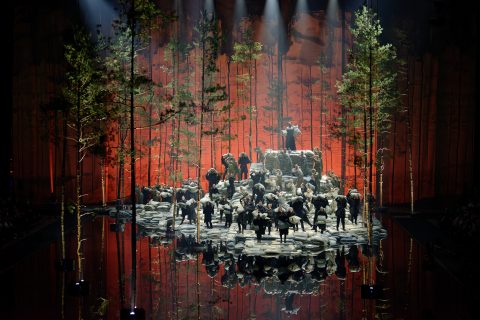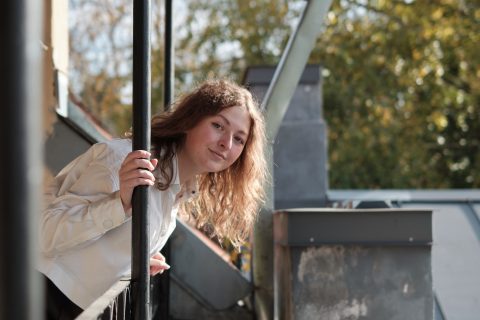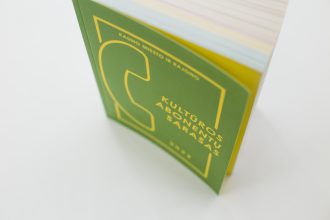Have you recently noticed transparent plaques attached to the entrances of some houses in central Kaunas? This is the project “Threshold” by the British artist Jyll Bradley, whose Jewish roots are here in Lithuania, which aims to recall the now exotic-sounding tradition of the mezuzah. It did exist in our city, before the Second World War, of course. Although many tragic facts have long been made public, it seems that we are only now understanding their actual weight and learning to come to terms with what a multilayered Kaunas was, could have been and wants to be today.
Kaunas – European Capital of Culture 2022’s Memory Office programme evokes the historical memory of the city and its surrounding settlements through storytelling, installations, performances, concerts, guided tours and murals. Right now, during the fourth edition of the CityTelling Festival initiated by the Office, we sat down with Dr Daiva Price, curator of the Memory Bureau, to discuss lessons learned, layers of dust blown away, and small, but maybe even the most essential, personal discoveries and sentiments.

Daiva, to begin with, how are you and the team at the Memory Office? The second part of the year seems to have been particularly intense for your program. Is there enough time to enjoy your colleagues’ events?
I can’t hide the fact that, like many of our colleagues, especially those who have been carrying the European Capital of Culture project on their shoulders since the beginning, we have been feeling the weight of the year. But it is great to see the fruits our partners, and we have been growing for so long. This is a harvest year when we finally see what we have been thinking about and planning for so long.
we set ourselves the goal of using the language of art to tell a story that did not receive enough attention in the public sphere or in cultural projects at the time.
With more than 1,500 events on the Kaunas 2022 programme, we can’t see everything… But I am very proud of my colleagues, who have proved that they are not only creative and professional but also can react quickly – neither a pandemic nor a war can beat them. When I am asked by foreign journalists how we have been affected by the recent disasters, I can only congratulate my colleagues on their projects such as Culture in the Courtyards, the CulturEUkraine centre and others. Born as a creative effort to adapt to tough challenges, some of these projects have also been awarded international prizes.
Has this year’s Memory Office programme achieved all the objectives set out several years ago? What has been even easier than you had hoped? Or perhaps some layers of dust proved too heavy and will have to be blown away by others?
I can say without any arrogance that we have achieved almost everything we planned. Since winning the title in 2017, my colleague Justina Petrulionyte-Saboniene and I have been interviewing Kaunas residents of different nationalities, uploading these conversations to the website atmintiesvietos.lt and accumulating an archive of stories that have become research material and a source of inspiration for many artists. It was vital to us that the collected stories should not end up being written down but be resurrected in different forms.
Around 2015, when we were preparing the European Capital of Culture bid, many historical topics were still somewhat taboo in Lithuania. Especially the Holocaust and World War II. Therefore, we set ourselves the goal of using the language of art to tell a story that did not receive enough attention in the public sphere or in cultural projects at the time. We wanted to destroy the myth of Kaunas as the most Lithuanian city, to promote openness to the other and the different, and empathy, which is so necessary in today’s world. At the same time, we felt obliged to recall the names and fates of those Kaunas citizens who lived before us, who built this city, who planned their future here. This is how the book “The Jews of Kaunas” was born, how the concert telling the story of the Kaunas Ghetto Orchestra was conducted, how the murals were painted, etc. Our programme is meaningfully complemented by partner projects – exhibitions, conferences, concerts…
Today, I wish we had more projects about the Polish, German or Tatar Kaunas. After all, Kaunas has always been like a tower of Babel, built by people of different nationalities, cultures and religions, and this is the strength and wealth of this city. I very much hope that these themes will continue to attract the attention of artists and cultural creators.
Turning the pages of Kaunas history one by one, what has surprised you the most over the years, both as an academic and city resident?
I am always pleasantly surprised by the people of Kaunas. They have a special love for their city, evidenced by the many groups on social networks where people share old photos, memories and historical knowledge. I don’t know if any other city has so many local history enthusiasts. Even though, until recently, Kaunas residents were proud of their Lithuanianness, I sense a great curiosity among visitors to our events to learn about a history left on the margins. After all, Kaunas was so diverse! I keep thinking about what we would be like today if the versatility that the city tragically lost had been preserved. What would Kaunas look like if we had not lost our enormous human, cultural and intellectual potential?
I am also amazed by Kaunas people like Karolis Banys and Petras Gaidamavičius, the founders of the Art Deco Museum. I am convinced this city has a future as long as there are such people. Karolis and Petras have not only altruistically opened the doors of their apartments to the European Capital of Culture projects and citizens, but they have also shown an extraordinary sensitivity to history, heritage and the people who lived in those houses. They have researched the fate of the people who lived there with great responsibility, meticulously recreating every authentic detail of the apartment! It is awe-inspiring that this is happening in my city.
Have you managed to sneak into the homes of those who preferred to keep their doors shut?
The door metaphor can be interpreted in different ways. On the one hand, it symbolises the values of openness, respect for the other and the alien, and dialogue. I can recall an episode from the first CityTelling Festival in 2019. We planned its significant events in a unique place – the so-called Tranquility (Ramybės) Park, or the Old Kaunas Cemetery, once shared by four denominations. It was crucial for us to involve the local (relatively closed) communities – Muslims and Russian Orthodox. We invited them to contribute to creating a musical cantata and to open the doors of the Mosque and the Orthodox Church, both located in the park, to visitors. At the end of the festival, we asked the clergy of all denominations to bless the city and its citizens. Our cultural project must have seemed like a strange adventure for religious communities. Nevertheless, they believed in us and were open to our proposed ideas. But at the end of the project, they admitted: “We had no idea how big a project we were getting into, we had no idea what was in store for us, we just trusted you.”
This trust results in a beautiful piece of music – the cantata “Peace, Peace” (released on vinyl this year) and a series of highly successful public tours. But most importantly, a new link has been forged between the city’s communities, and much-needed trust and dialogue have been established.
On the other hand, for years, we have been asking in the CityTelling Festival programme, what would you do if war came knocking on your door? We had no idea this metaphor would lose its hypothetical nature and become painfully real. The Memory Office programme, which talks so much about the Second World War, raises questions about historical lessons, humanity, and the value choices we make in the face of death and war that are very relevant today. This intertwining of historical narratives and current affairs can be seen in the reactions of visitors to the recently opened exhibition “Out of Darkness” by Jenny Kagan. The interactive show tells the story of the Holocaust through the experiences of a single family in a sensitive way. This exhibition shocks its visitors because of its power of suggestion and because it echoes today’s war experiences. Some have left the show with the following testimonial: ‘Slava Ukraini!’

So I believe that artworks help each of us to check ourselves – what will I do when the knock comes at my door? Do I open the door for someone who needs my help, or do I turn off the light and pretend I’m not home?
Which event, meeting, work or publication will remain your own most crucial sentiment from 2022?
Of course, one of our most important and challenging projects was preparing the book “The Jews of Kaunas”. This book is a tribute to those who lived before us and whose lives were so tragically cut short in this city. We felt our duty was to open a window on the rich life in Kaunas before the Second World War.
However, I value most the experience I have gained on this European Capital of Culture journey since 2014. The little things that happened along the way remain the most important for me, and I will share one of them.
For the 2019 Festival, we had an exceptional performance called “The Last Concert”. We wanted to recall the history of the Kaunas Ghetto Police Orchestra. Not many people knew that there was an orchestra in the Kaunas Ghetto, founded in the summer of 1942. And yet, it was home to all the most famous stars of the Kaunas music world who, until the Nazi occupation, entertained the audiences of Kaunas restaurants and theatres! The orchestra was led by conductor Moishe Hofmekler and concertmaster Abraham Stupel.
The highlight of the event was the piece “Yellow Fantasy (Fantasie in Gelb)”, composed in the Kaunas Ghetto. It was written by Percy Haid, or Peretz Hayat, a professional pianist and composer. He formed his own ensemble and travelled around Europe playing classical and popular music. In the Kaunas Ghetto, Haid, like many of his colleagues, became involved in the Kaunas Ghetto Police Orchestra. There, he was not only responsible for orchestrations but also composed a number of works. “Yellow Fantasy” was performed several times in the ghetto, and after the war, in 1949, in Chicago. It was performed for the first time in independent Lithuania in 2019.
But that is not the most important thing. A few weeks before the event, I received an email: “Good afternoon, I am Joseph Haid, son of Percy Haid. I am planning to come to Kaunas with my wife for “The Last Concert.”
Later, we met Joseph and his wife in Kaunas and showed him around the places where his father had lived and played before the war. He visited the concert and other festival events and then confessed: “I hesitated for a long time about going to Kaunas. My mother, who survived the Šiauliai ghetto, would never have understood because our whole family was killed there. I came for my father, but I didn’t know what to expect. We thought we would stay for a few days and leave again soon.” When he realised that the tragedy that had befallen the Jews of Kaunas was not forgotten, Joseph did not want to leave Kaunas. He said he would be sure to return with his son. For Joseph Haid, this timid journey to Kaunas was a homecoming, a great relief. And for us, such meetings confirm that what we do is meaningful. We are honoured to have been able to contribute to it.
This year’s CityTelling Festival is pleasantly long yet fast-paced – what else will the inhabitants and visitors of Kaunas and the Kaunas district experience?
Since mid-July, we have started to turn the pages of history that, unfortunately, are not yet fully known to us. Among them is the sculptural route in the city, “Threshold” by Jyll Bradley, which draws attention to a vanished community. The Maironis Lithuanian Literature Museum hosts a sensitive and original exhibition, “Dalia Grinkevičiūtė. Spaces / Overcome Distances”, dedicated to the testimonies of exile and occupation. The already mentioned exhibition “Out of Darkness” is a personal story of love, war, death and survival.
when we talk about history, we look into it for answers about today’s challenges and solutions to visions of the future.
In August, a klezmer programme of travelling musicians has already been performed in six towns in the Kaunas district. However, several events of the Litvak music programme will still be available. In the Kaunas District, we will invite you to an exhibition in Vandžiogala later this month, and in October to an exclusive silent film and music project, “Dibukas”, in Raudondvaris and Kaunas. At the end of September, we will host Kaunas 2022 Litvak Culture Forum and such spectacular musical projects as the Kaunas Cantata and the concert by Marija Krupoves at Žalgiris Arena. And in mid-October, we’ll look back at today’s Kaunas citizens and their stories. For two weekends, the city will host storytellers from all over the world in the programme “Where can I find you?”.

We will end the festival with a reflection on the future. In the international symposium “The Idea of Europe”, we will ask: What is the destiny of Europe? I hope this will become a meaningful culmination of the Memory Office programme. For years we have been asking, through various art projects, what have we learnt from history? What mistakes will we try not to make? After all, when we talk about history, we look into it for answers about today’s challenges and solutions to visions of the future.
What are the ambitions of the Memory Office in organising the Litvak Culture Forum? Which guests are you most excited about?
For me, this forum is like a wrap-up of the Jewish memory programme. It is a symbolic meeting of Litvaks from all over the world, of Kaunasians from all over the world, where we will discuss and share experiences and ideas. It is the culmination of years of efforts to build bridges of cooperation and dialogue.
This year’s programme is about the journey home. For us, this journey home symbolises a more profound knowledge of the city, its history and ourselves. At the same time, it is a return of Litvaks to the land of their parents, grandparents and ancestors. Kaunas 2022 has been an opportunity for artists such as William Kentridge, Jenny Kagan, Philip Miller, Bruce Clark, Marilia Destot and others to return with their work. Many of these artists will share their experiences in the Litvak Culture Forum. They will be joined by stars from the academic world, members of the Advisory Board of the Litvak Cultural Forum – Prof. Antony Polonsky, Prof. Peter Salovey, Prof. Tsvia Walden and others. The programme of the Forum includes both academic presentations and artist presentations. We will talk about the Litvak identity, memory, and the role of culture in creating possible visions for the future. We will raise questions about what it means to be Litvak today and how culture and art can help us understand history.
What is the significance of Kaunas Cantata in terms of artistic and emotional value?
Kaunas Cantata is a collaborative project between two Litvaks – artist Jenny Kagan (UK) and composer Philip Miller (PAR) – and many Lithuanian and international musicians. It concerns complex historical traumas and the need to remain silent. It is one of the most exciting and, at the same time, most challenging projects. The cantata invites us to open up about difficult traumatic themes. It invites us to confront ourselves, to talk about tough choices in the face of dramatic events. It is, therefore, particularly relevant in today’s context of war. At the same time, the project is also challenging from an organisational point of view, involving professionals and amateurs, children and adults, choirs and soloists, and musicians from Lithuania, Poland and South Africa. Bringing so many performers together in one place is a real challenge. On the other hand, the result will be all the more interesting.
What will the people exploring Kaunas a hundred years from now be saying about 2022?
2022 is a historic year in the life of the city, and I have no doubt that it will be discussed as a record-breaking cultural year. After all, more than 1,500 events will have taken place in less than a year! A year in which some 40 000 people gathered together on a cold January evening for culture. A year when 6 000 people gathered in the Žalgirio Arena not to cheer for basketball but to meet an artist.
However, Kaunas 2022 started in 2017 after winning the European Capital of Culture title. Therefore, Kaunas 2022 is a historical adventure of several years involving cultural organisations, artists, local entrepreneurs, and city and district communities. This collective adventure has led to new and unexpected partnerships (e.g., the Ninth Fort and Kaunas State Puppet Theatre), brought together and strengthened cultural and local communities (how many original initiatives in towns and courtyards!), and encouraged new topics and solutions regarding accessibility and communication, inspired innovations and new traditions (how many unique festivals, initiatives and ideas! ), pushed us to make bold decisions, and helped us to overcome the inertia and boredom of the city. We were pulling ourselves up by the hair and doing things we hadn’t dared to do before. It is definitely a time of courage and change. It is a journey that will never make Kaunas the same again.




